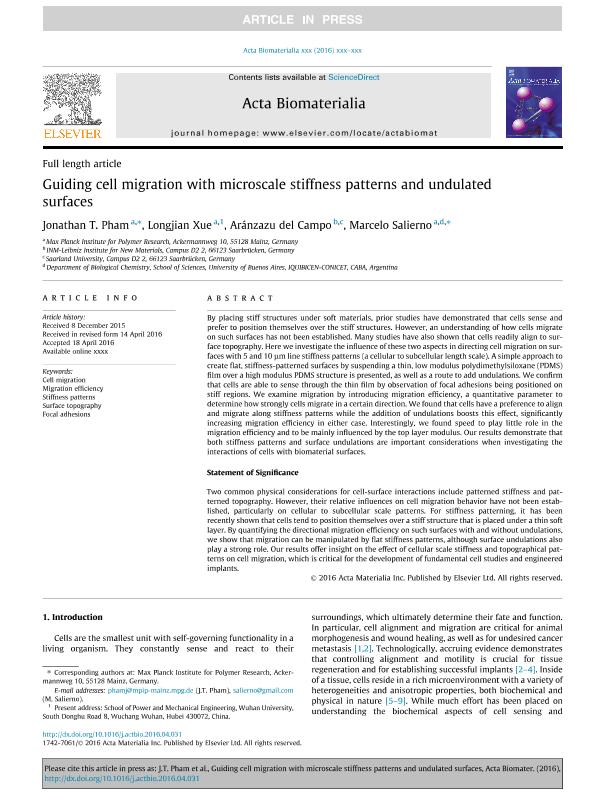Artículo
Guiding cell migration with microscale stiffness patterns and undulated surfaces
Fecha de publicación:
07/2016
Editorial:
Elsevier
Revista:
Acta Biomaterialia
ISSN:
1742-7061
Idioma:
Inglés
Tipo de recurso:
Artículo publicado
Clasificación temática:
Resumen
By placing stiff structures under soft materials, prior studies have demonstrated that cells sense and prefer to position themselves over the stiff structures. However, an understanding of how cells migrate on such surfaces has not been established. Many studies have also shown that cells readily align to surface topography. Here we investigate the influence of these two aspects in directing cell migration on surfaces with 5 and 10 μm line stiffness patterns (a cellular to subcellular length scale). A simple approach to create flat, stiffness-patterned surfaces by suspending a thin, low modulus polydimethylsiloxane (PDMS) film over a high modulus PDMS structure is presented, as well as a route to add undulations. We confirm that cells are able to sense through the thin film by observation of focal adhesions being positioned on stiff regions. We examine migration by introducing migration efficiency, a quantitative parameter to determine how strongly cells migrate in a certain direction. We found that cells have a preference to align and migrate along stiffness patterns while the addition of undulations boosts this effect, significantly increasing migration efficiency in either case. Interestingly, we found speed to play little role in the migration efficiency and to be mainly influenced by the top layer modulus. Our results demonstrate that both stiffness patterns and surface undulations are important considerations when investigating the interactions of cells with biomaterial surfaces. Statement of Significance Two common physical considerations for cell-surface interactions include patterned stiffness and patterned topography. However, their relative influences on cell migration behavior have not been established, particularly on cellular to subcellular scale patterns. For stiffness patterning, it has been recently shown that cells tend to position themselves over a stiff structure that is placed under a thin soft layer. By quantifying the directional migration efficiency on such surfaces with and without undulations, we show that migration can be manipulated by flat stiffness patterns, although surface undulations also play a strong role. Our results offer insight on the effect of cellular scale stiffness and topographical patterns on cell migration, which is critical for the development of fundamental cell studies and engineered implants.
Archivos asociados
Licencia
Identificadores
Colecciones
Articulos(IQUIBICEN)
Articulos de INSTITUTO DE QUIMICA BIOLOGICA DE LA FACULTAD DE CS. EXACTAS Y NATURALES
Articulos de INSTITUTO DE QUIMICA BIOLOGICA DE LA FACULTAD DE CS. EXACTAS Y NATURALES
Articulos(OCA CIUDAD UNIVERSITARIA)
Articulos de OFICINA DE COORDINACION ADMINISTRATIVA CIUDAD UNIVERSITARIA
Articulos de OFICINA DE COORDINACION ADMINISTRATIVA CIUDAD UNIVERSITARIA
Citación
Pham, Jonathan T.; Xue, Longjian; del Campo, Aránzazu; Salierno, Marcelo Javier; Guiding cell migration with microscale stiffness patterns and undulated surfaces; Elsevier; Acta Biomaterialia; 38; 7-2016; 106-115
Compartir
Altmétricas




